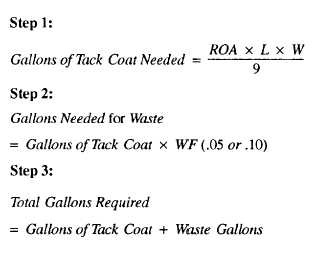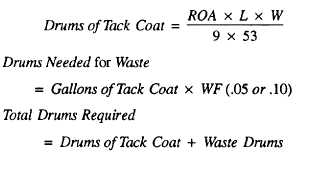coats are too heavy, they leave a surplus of asphalt that
bleeds into the overlying course. A thin tack coat does
no harm to the pavement and properly bonds the
courses.
Tack coat materials may be as follows: (1) a road
tar, grade RTCB 5-6, RT-6, 7, 8, 9, 10, or 11; (2) an
asphalt cutback, such as RC-250 or -803; (3) a diluted
emulsion; or (4) an asphalt cement, such as an AP-3
(85-100 penetration) or AP-1 (120-150 penetration).
Bituminous materials for the tack coat should be
applied in quantities not less than 0.05 or more than
0.25 gallon per square yard. The exact quantity
depends upon the condition of the surface to be
tacked. Normally, the construction project
specification denotes the ROA for the tack coat
application; however, when the ROA is not included
in the project specifications, the NCF uses an ROA of
.15 for planning and estimating purposes.
The procedure for estimating the bitumen required
for a tack coat is similar to that described for a prime
coat except that the tack coat is applied only over the
proposed width of the pavement.
The formulas for a tack coat estimates are as follows:
For computing gallons:
For drums, the formulas are as follows:
8-29






